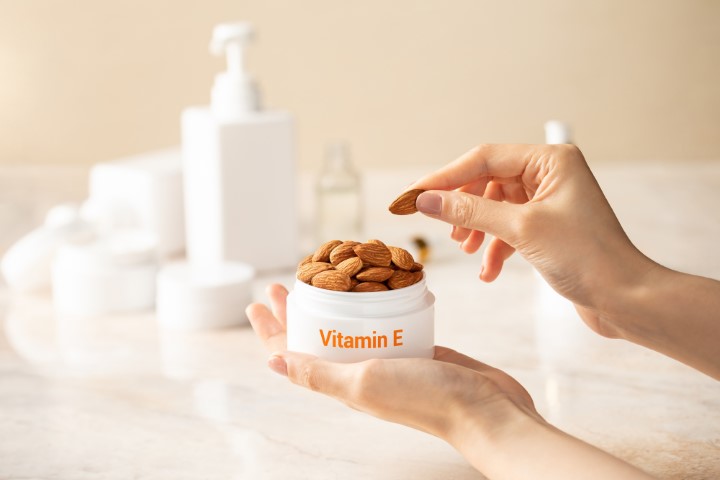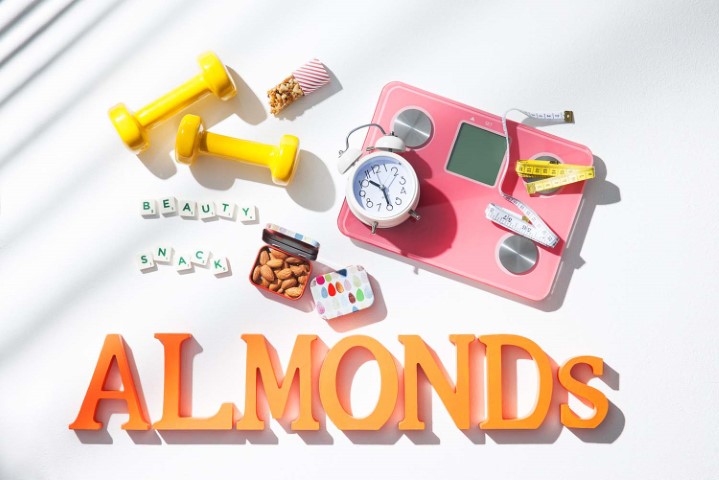New Study Suggests Almonds May Help Strengthen Skin’s Resilience to UVB: Healthy dietary choices make important contributions to skin health. In fact, researchers have begun to investigate how food choices might influence the skin’s intrinsic protection against damage from sun exposure – known as photo damage.
Avoiding prolonged sun exposure, wearing protective clothing and using topical sunscreen are key strategies to protect against photo damage, but research suggests that diet may play a supporting role. A promising new study[1] published in the Journal of Cosmetic Dermatology and funded by the Almond Board of California provides the first clinical evidence that consuming almonds may help support the skin’s resistance to UVB light.
Researchers at the University of California, Los Angeles (UCLA) investigated whether daily almond intake could increase resistance to UVB light(the main source of skin damage from sun exposure) and improve skin texture. The participants in the study were young women who self-identified as Asian,ages 18-45 years, with skin types that ranged from “burns and does not tan easily” to “burns a little and tans easily,” technically classified as Fitzpatrick skin types II, III or IV. The women were randomly assigned to eat 1.5 ounces (42 grams, 246 calories) of almonds or 1.8 ounces (51 grams, 200 calories)of pretzels daily for 12 weeks.Data from 29participants was analyzed at the completion of the study
UVB resistance was measured by quantifying the minimal erythema dose (MED) for each study participant at the beginning and end of the study. MED is the lowest dose of UVB light needed to cause slight skin reddening or erythema to a specific site on the skin. (In this case, inner-arm skin was chosen because it has little exposure to the sun.) Erythema is the first indication of skin photo damage, so increased MED indicates improved protection against (or resistance to) UVB photo damage.
At the beginning of the study, there were no differences in MED between groups. After the 12-week intervention, there was an increase in both MED (~20%) and exposure time to reach minimal erythema for women in the almond group compared to the pretzel group. No statistically significant changes in MED or exposure time were observed in the pretzel group.
“Our team is interested in whether certain foods can help maintain healthy skin and strengthen the skin’s natural defenses from within.This study strengthens the evidence that dietary choices can have a meaningful impact on skin health,” said principal investigator, Dr. Zhaoping Li, MD, PhD, Professor of Medicine and Chief of the Division of Clinical Nutrition, University of California, Los Angeles.“And this particular study showed that a daily snack of almonds (1.5 ounces, 42 grams) over 12 weeks improved MED – a measure of UVB resistance – in young Asian women by about 20%. The results suggest that including almonds in the diet may help support the skin’s internal defenses against UVB light.”
Secondary outcomes investigated in the study included measures of skin texture, sebum and hydration that were assessed by dermatologists. No significant differences were seen in these measures over time or between groups.
Speaking about the study, Dr. Geetika Mittal Gupta, Medical Director and Cosmetologist, said, “Most Indian women follow existing recommendations like wearing protective clothing and applying topical sunscreen to protect their skin from being exposed to UVB. It is interesting to note that eating almonds may support skin protection from the inside.. For years now, I have been recommending almonds as a natural healthy snack for better skin health – and the results of this study corroborate that. Besides this, almonds also contain healthy fats and vitamin E (alpha-tocopherol) that may benefit skin health.So I strongly suggest all Indian women to add a handful of almonds to their diet every day as an addition to what they are already doing to protect their skin .”
Commenting on the results of the study, Regional Head-Dietetics, Max Healthcare – Delhi, Ritika Samaddar, said, “The study results highlight how healthy food habits like adding almonds to the diet everyday,may support increased resistance to UVB exposure among women. In fact, another recent study found a measurable reduction in wrinkle severity and skin pigmentation intensity in postmenopausal women as a result of regular almond consumption[1]. I strongly urge women across India to take cognizance of these benefits, and make it a point to eat a handful of almonds everyday, to add to their skin’s overall health.”
Limitations of the study include a smaller study population than planned due to the exclusion of those participants found to be UVB resistant at the dose and exposure time selected. This study did not investigate the effect of sunlight exposure in general nor UVA exposure; findings are limited to protection against UVB radiation. This study also investigated a younger population. Further research is needed to investigate the effects of almond consumption for older subjects with moderate-to-severephotoaged skin and for other skin types/ethnicities.
Speaking about the study Sheela Krishnaswamy, Nutrition and Wellness Consultant commented, “Eating almonds regularly for a variety of health benefits ranging from heart health to skin is inbuilt in our traditions, and this study helps further corroborate this. This is the first of its kind research that highlights the positive impact of regular almond consumption in increasing the skin’s resistance to UVB light, in turn preventing the harmful effects of prolonged sun exposure, which is a very promising outcome. Women across India, should increase their almond intake and be sure to eat a handful everyday to achieve healthier skin.”
This study adds to other recent research investigating the potential role of almonds in skin health. A2019 pilot investigated the impact of daily almond consumption on wrinkles among 28 healthy, postmenopausal women with Fitzpatrick skin types 1 and 2 (type 1 – always burns, never tans; type 2 – usually burns, tans minimally). Women in the intervention group ate almonds comprising ~20% of their total daily calorie intake (~2 ounces/~60g almonds) and the control group ate a nut-free snack that accounted for 20% of daily calories. After 16 weeks, photographic image analysis showed reduced measures of wrinkle width (10%) and wrinkle severity (9%) for the almond group vs. the control group.
Almonds provide fiber (12.5 / 3.5 g per 100g / 30g serving) and 15 essential nutrients including (per 100g / 30g serving): magnesium (270 / 81 mg), potassium (733 / 220 mg), and vitamin E (25.6 / 7.7 mg).
Study at a Glance:
The Study
- This study investigated whether almond consumption can increase resistance to UVB light and reduce skin aging in young, healthy women who self-identified as Asian. The participants (n=29, ages 18-45 years) were women with Fitzpatrick skin types II, III or IV, and consumed either almonds or a calorie-matched snack daily for 12 weeks of either 1.5 ounces (42 grams, 246 calories) of almonds or 1.8 ounces pretzels (51 grams, 200 calories).
- At the start of the study, participants’ weight, height, skin type and skin characteristics including melanin (pigment), hydration, sebum (oil), erythema (redness) and facial Allergan Skin Roughness Scale (a numerical scale to evaluate roughness of skin before and after aesthetic treatments) were evaluated. They were measured again at 4, 8 and 12 weeks.
- The primary outcome measured in this study was the quantification of the minimal erythema dose (MED) of UVB light capable of inducing erythema (redness)to inner arm skin. Secondary outcomes measured were melanin, hydration, sebum, erythema and Allergan roughness in facial skin.The researchers established the lowest dose of UVB that induced MED in a previous study.The results of MED to the inner arm is a validated measure of overall skin health; the inner arm is used because it typically does not get sun exposure so changes in photo-damage can be measured.
- Within the almond group, there were more participants with Fitzpatrick skin type IV, but the difference was not statistically significant. Dose and timing of UVB exposure were adjusted to skin type.
Results
- For the almond group, there was a significant increase in MED and in exposure time required to induce erythema at the final visit (12 weeks) compared to the start of the intervention (baseline) (p=.006). Further, the increase in MED in the almond group was statistically different compared to the pretzel group.
- For the women who consumed almonds, there was an increase in MED from 415±64 to 487±59 (18.7±19.2 %,p+0.006) from baseline to week 12 compared to women in the pretzel group from 415±67 to421±67 (1.8±11.1%).The exposure time to reach minimal erythema (redness) was also increased significantly in the almond group from 160±23 to 187±25 (17.5±22.2%) compared tothe pretzel group from 165±27 to 166±25 (1.7±14%) (p=0.026).
- At baseline, the groups had no significant differences of MED, which indicated the change in MED was due to the almond intervention.Increased MED and exposure means that a higher does of UVB light was required to induce erythema (redness) after 12 weeks compared to the pretzel group.
- There were no significant differences between the two groups in their ratings of erythema or Allergan Skin Roughness by dermatologists’ assessment.
- There were no significant differences in melanin index, sebum hydration or erythema by cutometer reading.
- The mechanism for the improvement in UV resistance with the almond intervention is currently unknown. The researchers speculate that the nutrients in almonds(mono- and polyunsaturated fatty acids, vitamin E, quercetin (a flavonoid), and other phenolic and polyphenolic compounds, may improve the antioxidant and anti-inflammatory capacity of human skin, which could be responsible for the increased photo protection against UVB light.
Conclusion
A daily snack of almonds (1.5 ounces, 42 grams) improved UVB resistance in young Asian women who consumed almonds for 12 weeks.The results suggest that including almonds in the diet may help support the skin’s internal defenses against UVB light.








